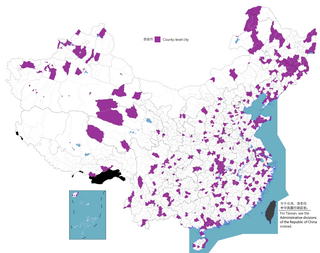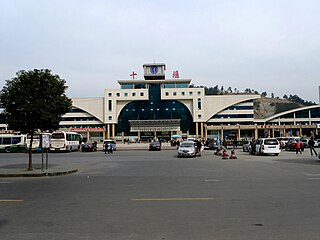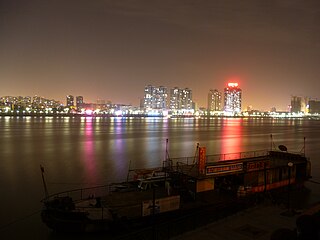
Provincial-level administrative divisions or first-level administrative divisions, are the highest-level Chinese administrative divisions. There are 33 such divisions, classified as 22 provinces, four municipalities, five autonomous regions, and two Special Administrative Regions. All but the disputed Taiwan Province and a small fraction of Fujian Province are controlled by the People's Republic of China.
A sub-provincial division in the People's Republic of China is like a prefecture-level city that is governed by a province, but is administered independently in regard to economy and law.

Prefectures, formally a kind of prefecture-level divisions as a term in the context of China, are used to refer to several unrelated political divisions in both ancient and modern China. There are 334 prefecture-level divisions in China. They include 7 prefectures, 293 prefecture-level cities, 30 autonomous prefectures and 3 leagues. Other than provincial level divisions, prefectural level divisions are not mentioned in the Chinese constitution.

Wanzhou District is Chongqing's second most populated urban core area on the upper reaches of the Three Gorges of the Yangtze River in China. It is currently governed as a district of Chongqing Municipality, bordering Sichuan to the northwest and Hubei to the southeast. It was formerly known as Wanxian or Wan County. Prior to Chongqing's formation as a direct-controlled municipality, Wanzhou was part of Sichuan province. The urban core of Wanzhou is 228 km (142 mi) away from Chongqing's city proper.

A county-level municipality, county-level city, or county city is a county-level administrative division of mainland China. County-level cities are usually governed by prefecture-level divisions, but a few are governed directly by province-level divisions. Formerly known as prefecture-controlled city.

Jingzhou is a prefecture-level city in southern Hubei, China, located on the banks of the Yangtze River. Based on the 2010 census, its total population was 5,691,707, 1,154,086 of whom resided in the built-up area comprising the two urban districts.

Shiyan is a prefecture-level city in northwestern Hubei province, China, bordering Henan to the northeast, Chongqing to the southwest, and Shaanxi to the north and west. At the 2010 census, its population was 3,340,841 of whom 767,920 lived in the built-up urban districts of Maojian and Zhangwan on 1,193 square kilometres. In 2007, the city was named China's top ten livable cities by Chinese Cities Brand Value Report, which was released at 2007 Beijing Summit of China Cities Forum.

Laiwu was a prefecture-level city in central Shandong Province, China. Bordered the provincial capital of Jinan to the north, Zibo to the east and Tai'an to the southwest, it was the smallest prefecture-level city in the province. It had a population of 1,298,529 at the 2010 census, and became part of Jinan in 2019.

Xiangyang is a prefecture-level city in northwestern Hubei province, China and the second largest city in Hubei by population. It was known as Xiangfan from 1950 to 2010. The Han River runs through Xiangyang's centre and divides the city north-south. The city itself is an agglomeration of two once separate cities: Fancheng and Xiangcheng. What remains of old Xiangyang is located south of the Han River and contains one of the oldest still-intact city walls in China, while Fancheng is located to the north of the Han River. Both cities served prominent historical roles in both ancient and pre-modern Chinese history. Today, the city has been a target of government and private investment as the country seeks to urbanize and develop the interior provinces. In 2017, population of the prefecture-level city was 5.65 million, in which 3.37 million were urban residents.

Zaoyang is a city in the north of Hubei province, People's Republic of China, bordering Henan province to the north. Administratively, it is a county-level city under the administration of Xiangyang. At the 2010 census its population was 1,004,741 inhabitants even though its built-up area is much smaller.

Wangcheng District is one of six urban districts of the prefecture-level city of Changsha, the capital of Hunan Province, China. It is the largest district of Changsha by area. The district is bordered to the north by Miluo City and Xiangyin County of Yueyang, to the west by Heshan District of Yiyang and Ningxiang County, to the south by Yuelu and Kaifu Districts, to the east by Changsha County. Located in the northsouth of the City proper in Changsha, Wangcheng covers 951.06 km2 (367.21 sq mi) with registered population of 560,567 and resident population of 562,100. The district has 10 subdistricts and 5 towns under its jurisdiction, its administrative centre is at Gaotangling Subdistrict.

Daye is a county-level city in eastern Hubei province, China. It is under the administration of the Huangshi prefecture-level city.

Dingcheng District is one of two urban districts in Changde City, Hunan Province, China; it is also the 2nd most populous district in Hunan. The district is bordered to the north by Anxiang County, Jinshi City and Linli County, to the west by Taoyuan County, to the north by Anhua and Taojiang Counties, to the east by Hanshou County, Wuling District is in the central west of Dingcheng District. Dingcheng is the largest district by population or by area in Hunan, it has an area of 2,322.5 kilometres (1,443.1 mi) with 764,700 of registered population. It is divided into 4 subdistricts, 19 towns and 1 township, its government seat is Hongyun Subdistrict (红云街道).

Anxiang County is a county in Hunan Province, China, it is under the administration of the prefecture-level city of Changde. The County is located on the north in Hunan Province and the southeast in Changde City, it borders to the north by Gong'an County, the west by Li County, Jinshi City and Dingcheng District, the south by Nan County, the east by Shishou City, it has an area of 1,087 kilometres (675 mi) with 602,299 of registered population and 525,619 of permanent resident population. It is divided into 8 towns and 4 townships under its jurisdiction. The county seat is Shenliu (深柳镇).

A municipality, formally as municipality under the direct administration of central government, is the highest level of classification for cities used by the People's Republic of China. These cities have the same rank as provinces, and form part of the first tier of administrative divisions of China.



















